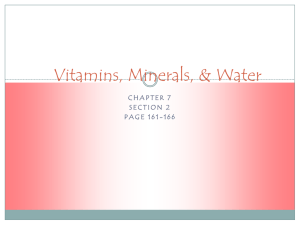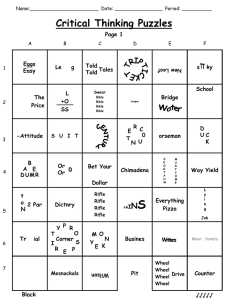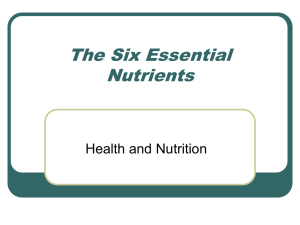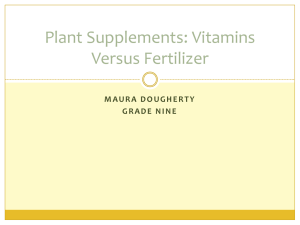Vitamins and Minerals
advertisement
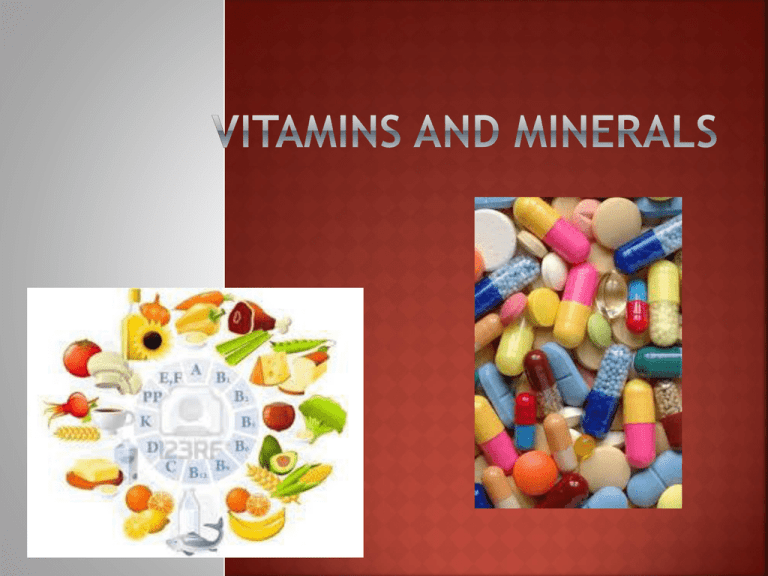
One of the first discoveries of the importance of vitamins came in the 1700s. A Scottish doctor, James Lind, discovered that sailors who were fed citrus fruits recovered from scurvy. Today, health scientists know that scurvy is caused by a lack of vitamin C, which is found in abundance in citrus fruits. Slide 2 of 27 Nutrients that are made by living things, are required only in small amounts, and that assist many chemical reactions in the body are vitamins. There are two classes of vitamins fat-soluble vitamins—dissolve in fatty material water-soluble vitamins—dissolve in water Slide 3 of 27 Fat-soluble vitamins can be stored by the body Vitamins A, D, E, and K are fat-soluble vitamins Sources of fat-soluble vitamins are vegetable oils liver eggs certain vegetables Slide 4 of 27 Water-soluble vitamins cannot be stored by the body. Examples of water-soluble vitamins are C and all of the B vitamins. Sources of water-soluble vitamins are fruits vegetables whole-grain foods and many other foods Slide 6 of 27 Vitamins called antioxidants help protect healthy cells from the damage caused by the normal aging process as well as from certain types of cancer. Vitamins C and E are two of the most powerful antioxidants. Slide 9 of 27 Your body requires only small amounts of minerals, which are nutrients that occur naturally in rocks and soil. You need seven minerals—calcium, sodium, potassium, magnesium, phosphorus, chlorine, and sulfur—in significant amounts. Slide 10 of 27 Calcium is important in blood clotting and the functioning of your nervous system. It is an essential ingredient in the formation and maintenance of bones and teeth. A lack of calcium can sometimes lead to osteoporosis, a condition in which the bones gradually weaken. Slide 12 of 27 Potassium and sodium work together to maintain water balance in the body. Slide 13 of 27 Iron is necessary for healthy red blood cells. If a person’s diet does not include enough iron, he or she may develop anemia, a condition in which the red blood cells do not contain enough hemoglobin. Slide 14 of 27 Sodium is important in several body processes, including the functioning of the heart and water balance. Too much sodium can cause a problem with blood pressure. Slide 15 of 27 Slide 16 of 27 Slide 17 of 27 Vitamin and mineral supplements, therefore, are not usually necessary if your diet is nutritious and wellbalanced. An excess, or overdose, of vitamins or minerals may damage your health. If you do take a vitamin or mineral supplement, a health care provider can advise you about how much is the right amount. Slide 18 of 27 Deficiency disease Phytochemicals Niacin Major Minerals Trace Minerals Bioavailability Megadose Folic Acid Vitamins Minerals Water-soluble vitamins Fat-soluble vitamins 1. A. B. C. What are the two categories of vitamins? How are they different? Give examples of each. 2. A. How long have vitamins and minerals been known about? B. How does technology help? C. How has this knowledge made some diseases less likely? 3. How are vitamins and minerals different? One of the first _____________________ of the importance of vitamins came in the _____________. A ________________ doctor, _____________________, discovered that _______________ who were fed citrus fruits recovered from ______________. Today, health scientists know that _______________ is caused by a lack of ___________________, which is found in ____________________ in citrus fruits. Slide 22 of 27 ___________________ that are made by living things, are required only in ___________ amounts, and that assist many ________________ reactions in the body are ___________________. There are ____ classes of vitamins ___________________ vitamins—dissolve in fatty material _____________________vitamins—dissolve in water Slide 23 of 27 Fat-soluble _____________ can be stored by the body Vitamins __________________________________ are fat-soluble vitamins Sources of fat-soluble vitamins are vegetable oils _______________ eggs certain vegetables Slide 24 of 27 Water-soluble vitamins __________________ be ___________________ by the _____________. _________________ of water-soluble ____________ are C and all of the ______ vitamins. Sources of water-soluble vitamins are ________________________ vegetables ______________________________ and many other foods Slide 26 of 27 Vitamins called _________________________ help protect healthy cells from the damage caused by the ________________ aging ________________ as well as from certain types of _____________________. Vitamins _______ and _________ are ________ of the most _____________________ antioxidants. Slide 29 of 27 Your body _________________ only small amounts of _____________________, which are nutrients that occur _____________________ in rocks and ____________. You need __________ minerals—calcium, ____________, potassium, ______________, phosphorus, __________, and sulfur—in significant _______________. Slide 30 of 27 __________________ is important in _____________ clotting and the __________________ of your ______________________ system. It is an _________________ ingredient in the formation and _________________________ of ______________ and teeth. A ____________ of calcium can sometimes _______ to ________________________, a condition in which the ______________ gradually ___________________. Slide 32 of 27 ________________________ and ____________________ work together to maintain water _______________ in the _______________. Slide 33 of 27 Iron is necessary for healthy _____________________________________. If a person’s __________ does not include __________ iron, he or she may develop _________________, a ___________________ in which the red blood cells do not contain enough ___________________________. Slide 34 of 27 ____________________ is important in ________________ body ____________________, including the functioning of the _______________ and water __________________. ___________ much ___________________can cause a problem with _________________________. Slide 35 of 27 Slide 36 of 27 Slide 37 of 27 ____________________ and mineral supplements, therefore, are not usually __________________ if your diet is nutritious and _______________________. An _________________, or overdose, of _________________ or minerals may _______________ your _____________________. If you do take a vitamin or mineral _____________________, a health care ________________ can advise you about _________ much is the ___________________ amount. Slide 38 of 27 Deficiency disease Phytochemicals Niacin Major Minerals Trace Minerals Bioavailability Megadose Folic Acid Vitamins Minerals Water-soluble vitamins Fat-soluble vitamins 1. A. B. C. What are the two categories of vitamins? How are they different? Give examples of each. 2. A. How long have vitamins and minerals been known about? B. How does technology help? C. How has this knowledge made some diseases less likely? 3. How are vitamins and minerals different?
